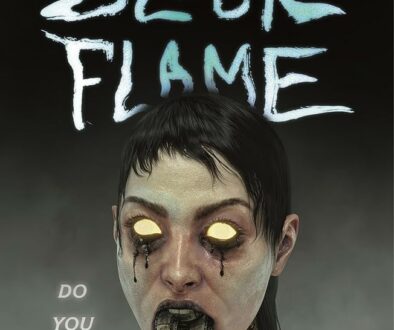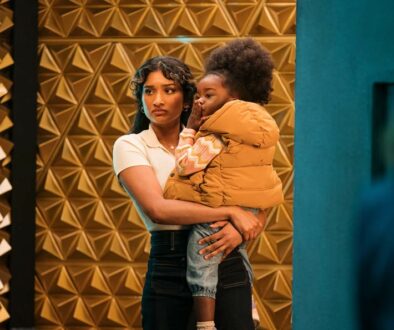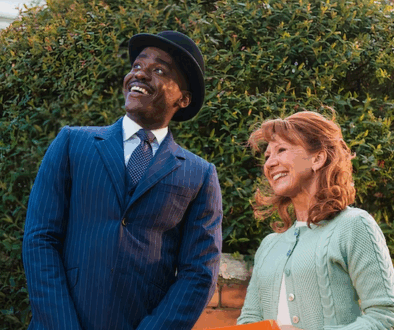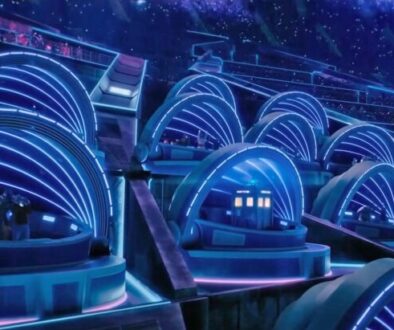Davies in the Anxious Interval
Last War in Albion will return next week with the first of ten posts on Doom Patrol.
The music critic and musician Momus formulated a model of nostalgia cycles that hinges on the concept of the anxious interval. It goes something like this: we live in, unsurprisingly, the present—a concept that does not simply entail the here and now, but the last couple of years—any point in the culture that does not feel in some fashion “dated.” Momus suggests that “If you can look at a photo of yourself and not think ‘God, what a strange haircut I had, and what strange sunglasses I was wearing!’ then that photo was probably taken in the present.”
Sitting immediately behind the present, however, is the anxious interval—the awkward period of culture which has started to look dated, but is not yet old enough to reclaim and repurpose. As Momus puts it, “the anxious interval is a place, a style, a set of references we avoid, repress, sublimate, have selective amnesia about, stow away, throw out, deliberately forget”
Past the anxious interval is the goldmine—the points in culture that can be freely reclaimed and repurposed, and indeed from which the present’s sense of “cool” is usually being borrowed. (There’s also a tiny borderzone between them, the battlefront, which is where the cutting edge of tastemakers are currently sorting and writing a variety of “X IS GOOD ACTUALLY” hot takes—the point where the past is actively being contested, basically.)
And then, further back, is the anxious echo—the period that served as the goldmine for the anxious interval, and that is thus being forgotten along with it. Unlike the anxious interval’s forgetting, which exists so that it can be undone later as the goldmine, the anxious echo is being forgotten with some permanence; it will resurface simply as the past, a vast and undifferentiated set of old stuff, some bits perhaps easier to access than others at any given moment, but mostly just old. Crucially, what’s remembered will either be individual things—Dune, for example—or will be remembered within a single history-minded work—Last Night in Soho is certainly about the 1960s, but it’s not the vanguard of any sort of 1960s revivalism—it’s just a period piece. Another wholesale 1960s revival is now about as likely as an 1860s revival.
A few months ago my friend Alex made a mixtape for his Patreon themed around the anxious interval—a collection of music from the current interval that he felt held up and was thus interesting to look at from the vantage point of the present. The years he selected for this exercise were 2005-2009, which you may recognize as a set of dates that also describes the Russell T Davies era. Which is interesting given that the Russell T Davies era is on its way back.
The idea that the anxious interval sits somewhere around the Davies era checks out, at least within television. After all, The Sopranos (1999-2007) just exited its anxious interval into massive celebration—remember five years ago when we were all desperately tired of Troubled Male Antiheroes in prestige television, when HBO embarrassed itself massively with Vinyl? Well, not anymore.
Now, of course, the obvious thing to point out is that the Davies revival is going to go out in 2023–the absolute earliest scenario sees him running a hastily slapped together New Year’s special before a fall season. So he’s probably actually perfectly timed to be navigating his own entrance into the battlefront. But I think this is still a useful frame to think about the Davies era in terms of aesthetic shifts, if only because Doctor Who fans tend to isolate their sense of aesthetics into eras, or to simply not have any sense of aesthetic shifts and gamely continue listening to the twenty-second consecutive year of Nicholas Briggs audios. But if there was one thing the Davies era wanted to do it was to root Doctor Who very firmly and explicitly in the aesthetics of its time. So let’s spend some time thinking about his era and the prospect of its return in those terms.
For simplicity’s sake, let’s focus our discussion on the New Earth trilogy, which covers a fairly wide swath of the Davies era, is particularly sold by visuals, and gets a pretty solid sampling of the quality levels of the time. Off the bat, there is a degree of “was it really like this?” here: the sheer amount of colored lighting, the camera angles, the depth of focus and video quality of the Betacam cameras, all of it looks wrong today. It looks cheap in ways it didn’t at the time—especially The End of the World, which was in practice the show ostentatiously showing off how much budget it had now. Some of the prosthetics still look good—the Moxx of Balhoon remains impressive, although just look at how much of it is static when he talks, or wobbling as the platform rolls across the floor. But more than the quality of the effects, which wasn’t terribly interesting to talk about in 2005 and still isn’t, what stands out is what they’re being used for. The overall aesthetic, in all three of these, is one of strangeness. We’re being asked to look at aliens and find them unusual—objects of spectacle in a way the show doesn’t generally do anymore. (It’s telling that the Chibnall era handles its alien planets is to focus on landscape shots from the location shoots, which is visually impressive but the polar opposite of strangeness.)
More broadly, as About Time notes, the visual aesthetics for these stories are largely drawn from 1970s science fiction, particularly the work of Moebius. Here we find our anxious echo, then—the period actively being forgotten as the critical mass of people who remember it dwindles. For Davies, of course, this was childhood Doctor Who—the natural thing to draw from as someone born the same year as the program. But at 58 he’s among the youngest people with clear memory of that decade, and its influence is on the permanent wane.
Not all of this is going to come back in RTD2 era, of course—hell, even Davies wasn’t shooting on Betacam by the end. And I’d be surprised if we thoroughly re-embraced 1970s design—although Davies does do some of his own concept sketches so it probably won’t disappear entirely. But it’s safe to assume that some of these visual oddities, whether the choice of camera angles or the colored lighting or what, are on their way back in some form. If nothing else, I’d be shocked if we don’t see a very decisive reaction against the prevailing visual aesthetic that critic Kate Stebbins calls “the intangible sludge” (think in terms of the flat and muted color grading of basically every Marvel film) and back towards a vibrant color palate.
But these are superficial visual elements. Let’s dig deeper. One thing that has stood out sharply in the Chibnall era is the cack handed ways in which it has handled its sense of emotional storytelling. And likewise, watching the Davies era it’s striking just how efficient the emotional beats are. The End of the World, for all that it’s a somewhat sloppy and often disposable piece, is meticulously organized to get that final beat of the Doctor and Rose standing in the middle of the street deciding to get chips. Gridlock, meanwhile, is bookended by the Doctor’s two moments of describing Gallifrey to Martha, with the intervening story being an efficient effort at getting him from one to the other. Even New Earth, which lacks much in the way of emotional beats for the Doctor and Rose, has a well-structured arc for Cassandra with an effective sting at the end.
What’s striking, though, is how arbitrary these emotional stakes are for the actual episode contents. The End of the World is probably the most tethered—Rose’s arc is fundamentally tied to watching her planet burn, or, more accurately, failing to do so. But there’s still a kind of kitchen sink vibe to this—the Moxx of Balhoon, blue people, robo-spiders, an (on script level at least) pair of The Web Planet shout-outs, talking trees, Cassandra, all the other weird aliens, “Toxic” and “Tainted Love,” none of this actually especially fits together for any reason other than that Davies makes it work on the screen. The same absolutely applies to New Earth (return of Cassandra, “let’s do an alien planet,” cat nuns, medical horror…) and Gridlock (cars, religion, more cat people, emotions as drugs…), neither of which particularly attach to their concepts in any way other than the fact that they share forty-five minutes of space and are done well enough to cohere.
This does not feel like the way you’d do it now—indeed it feels actively counterintuitive. Good sense and most writing advice tells you that you start from your emotional arc and then you find a way to allegorize it, possibly very, very literally. That’s really not what Davies does, though. Davies seems instead to do two separate sets of structuring—a season arc, typically built around the questions “what do I want for my spectacular finale” and “what’s my companion’s emotional arc,” and then a separate thing-of-the-week structure that very much treats Doctor Who as an anthology show, and that tends to be structured around a very rigorous set of slots. (Broadly: an opening three that do past-present-future in some order. A lighter two-parter, usually with a returning monster. Some weaker filler. A darker, scarier two-parter. The cheap one. The weird one. The finale.) And then he sets about getting the beats from the arc to fit into his anthology structure.
There are several things here that seem as though they are ripe for revival. The dominance of streaming platforms and bingewatching as the norm has given rise to television where the standard unit of storytelling is the season. A correction back towards the episode as the unit of storytelling would be timely and fresh, especially off the back of Chibnall’s last two seasons, which included a “the whole season is one story” and a season whose ten episodes included both a two-parter and a three-parter with a giant arcy bomb tossed in the middle. Moving back towards Doctor Who feeling like a big anthology with wild tonal swings between individual episodes would stand out—how long has it been since “the funny one” and “the scary one” were meaningful aesthetic distinctions within a Doctor Who season, after all?
But there’s a larger aspect of Davies’ methodology worth highlighting: the sheer maximalism of it. Think about sequences like the Doctor jumping downwards through a sequence of cars in Gridlock, the parade of aliens in The End of Time, or even the bevy of sci-fi diseases in New Earth. Or, perhaps more to the point, to the lists of concepts all of those stories had—the way they’re so utterly fearless about throwing in a new concept for the sake of it, even if they don’t mean to flesh them out. Or just those visuals, with their constant devotion to the belief that more is more.
Evan Collins of the Institute for Y2K Aesthetics has identified an aesthetic period he describes as “McBling,” which he describes as “a hard shift away from the minimalist futurism of the Y2K era towards maximalist remixes of mainly 1970s and early 1980s trends & motifs. Aspirational luxury in all forms, tattoo motifs, oversized designer glasses, celebutantes, designer ripped jeans, pink hummers, bedazzled electronics, fashion phones, McMansions, nihilistic & hedonistic overtones, overly-flourishy vector art, grunge effects applied to ‘gothic’ fonts, reality tv shows, Paris Hilton, tuscan-inspired-everything in home furnishings, luxury trips around the world, excessive overbuilding of homes (global housing bubble), designer dogs, dubai, bling, spinning rims, trucker hats, von dutch, ed hardy, spray tans, tracksuits, Juicy Couture, american flag inspired clothing post-9/11.” And I would argue that the Davies era was absolutely a part of this—the scene that most spectacularly springs to mind is in New Earth when the Doctor clads himself in a kaleidoscope of brightly colored “medicine bags,” not because IV bags are bling per se, but because of that visual of a huge number of lush, jewel-like colors. But the interior of the TARDIS, high and cathedral-like, also stands out.
We can see the part of this that isn’t going to come back per se—the anxious echo of the 1970s and 80s. But there’s real and obvious potential in a return to maximalism—an aesthetic of excess and absolutely no restraint. This is not the part of the Davies era that is well-remembered—which is, in part at least, the point. But it’s the tendency that seems most absent in the restrained, naturalistic visuals of the Chibnall era, or even in the bulk of the Moffat era. It is the thing Davies could most obviously do to feel different again, even if it is in many ways a repetition of his previous tricks.
My point in all of this is to suggest that for all that Davies is a move backwards and a refusal to push Doctor Who into the future, which is to say into a writer not based in classic series fandom, there’s a real potential here. Davies is a retreat into the past, but he’s a retreat into the precise era of the past that’s most likely to see itself culturally rehabilitated in the immediate term—the bit of the past most likely to next become the future. He’s a weird choice of throwback in 2021, and when it comes to Doctor Who, “weird” has always been the most important thing.






December 13, 2021 @ 1:52 pm
I do have some sympathy for the Big Finish fans, because I myself would be happy to spend 22 years revisiting that one joke at their expense.
December 14, 2021 @ 4:08 am
Thanks for this. I’ve been avoiding the threads of speculation elsewhere, but anticipated that I’d share your views.
One bit of a ‘throwback’ that I’d like to see – the Doctor as a scientist, and science as something of a running theme in season 2023.
December 15, 2021 @ 10:11 pm
The Doctor being a scientist… I think it’s been deemphasized in recent years because some people fear that’s going down a path where the show becomes overly pedantic, and focused on explaining how all the Doctor’s stuff works. I remember Moffat in particular deriding that kind of technobabble as only something fans who write and read Star Trek Technical Manuals would care about.
And to be clear, all of that is true to a degree, like part of why I’ve (so far) been unable to connect with Star Trek: TNG like I have with TOS are the scenes where characters are just spouting off soulless technobabble. And I certainly wouldn’t want an episode where it’s just the Doctor explaining how the Sonic Screwdriver does what it does. But look at something like the Magic School Bus: It’s literally IN THE NAME that there’s magic involved, but it’s still an educational science show that can teach you (and me, watching the show as a kid) so much about science and the scientific process, and doesn’t need (nor should it) go down any pedantic technobabble path.
Basically, the magic and science of Doctor Who can coexist, and need not be in competition with each other.
December 15, 2021 @ 9:59 pm
Thanks for this! Lots of fun to read on how to look back at RTD, in 2021, with episodes that for some fans are easy to otherwise mock and deride. For me my favourite moment is the ending of Gridlock, where the Doctor reminisces about Gallifrey as the drivers flies above New Earth once again, while the choir plays one more time. It’s such a beautiful scene that’s often overlooked, where the Doctor finally opens up to his still-new companion in a way he hasn’t in so long.
Also, I have to correct this since I’ve known them personally for a long while: Evan Collins’ “Institute for Y2K Aesthetics” is now called just CARI. It’s short for “Consumer Aesthetics Research Institute”, and was created to properly describe how we’ve expanded our horizons beyond the Y2K Aesthetic (such as McBling).
December 19, 2021 @ 5:48 pm
I really enjoyed that and I hope you’re right in regards to the aesthetic we can expect from RTD2.
Also, thanks for introducing me to the idea of the anxious interval – fascinating stuff.
December 20, 2021 @ 12:59 am
“Another wholesale 1960s revival is now about as likely as an 1860s revival.”
Given the state of American politics, this is actually a chilling comment for me.